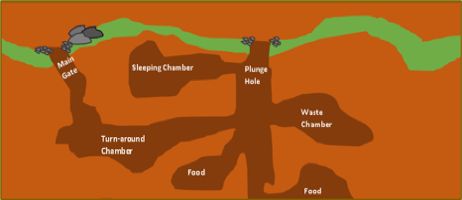It’s natural to feel disturbed if catching an unwelcoming creature in your yard who destroys crops. Yeah, I’m talking about the woodchuck aka groundhogs. They make themselves comfortable and ruin the yard by making tons of holes.
So, how to plug groundhog holes? Using cement, water, and aggregate in a 2:1:7 ratio to make the mixture and fill the hole will help plug it. This trick will take 1 – 2 days to harden the surface. Other than that, you can use tunnel fill to get it done in 30 minutes.
In this article, I’ll explain the procedure and bring other handy details which will help you get the in-depth data.

Method to Plug Groundhog Holes Using Cement!
Plugging or filling groundhog holes with cement is possible if you can make the proper texture using water and aggregate. Here’s how to fill groundhog holes:
- Take a bucket and fill 20 cups (4.73 liters) of water.
- Fill 10 cups of white or grey cement based on your reach in the water.
- Use 70 cups of aggregates in the water-cement solution and mix them well.
- Locate the hole and fill the hole using the mixture.
- Gradually fill the hole completely so that it never opens up. You have to cover every corner as much as possible.
- After applying the solution, level the surface using a scraper.
- Place the plastic bag on top of the solution so that nothing ruins the texture.
- Do not touch the surface for 1 – 2 days.
- Then, check if the surface gets hardened or not. If not, wait for the next day. Done!
Use Tunnel Fill to Fill a Groundhog Tunnel
The instruction is easy to try as long as you got all the tools needed. Be sure the tunnel fill and garden hose are prepared. Now, follow the given steps:
- Locate the groundhog hole which seems newly built to avoid hitting on the wrong spot.
- Connect the garden hose to the nearby water supply. Check the flow of water and grab the hose in front of the tunnel.
- Fill water inside the groundhog hole so that it gets wet for 2 minutes at high speed. Switch the water flow to medium and fill water in the tunnel for 4 minutes.
- If the hole seems not filled properly, then use the tunnel fill inside so that the whole hole is covered.
- Wait for 10 minutes.
- Turn on the water supply and fill the hole. Again, add the tunnel fill if it seems not too full then wait for 10 minutes.
- Use the tunnel fill in the hole If needed.
- Fill some water.
- Let it sit there for a few minutes. Then, check in the next morning to confirm the success.
Use Solid Material to Fill Groundhog Holes!
The burrow or hole that a groundhog makes can be covered if using a solid material like concrete, stone, raw bentonite, or clay in a liquid formation.
If you are trying to fill the hole from top to bottom, it would be better to use concrete or clay in a liquid form so that the solution flow to the gaps and gets hard the next morning. However, for small holes, using stone will work like magic to cover the gaps in a decent way.
Groundhog Holes Look Like This
The hole of the groundhog looks like a small dig unless you look beneath the ground to find the huge rooms. They make 2 holes to come out in different directions (one is a plunge hole while another is a main gate or entrance).

Right next to the plunge hole, there’s a small room for the groundhog to sleep over (a sleeping chamber). Moving forward to the plunge hole, you’ll find another hole that is used for urinating (waste chamber).
Whether do woodchucks chuck wood or not, they make sure to store the food before going to hibernation mode. And so, beneath the waste chamber, you’ll see space for food (mostly make 2 or 3 holes for this purpose).
On the other side, there’s a turn-around chamber to simply go to the main gate. This is basically what it looks like!
You Can Flood a Groundhog Hole
Water won’t cause them to drown nor do they like this element. The groundhog will simply swim and pop up to the hole if meet water.
Using the proper amount of water that is able to fill the groundhog hole will be ideal to flood the areas. This trick works excellently to catch them.
You can also use some scents which they dislike inside the water so that they feel trapped inside the hole and come out immediately. Learn more if you want to know how to catch a groundhog with a milk jug.
Get Rid of Groundhog Tunnels
Using woodchuck bait for live trap, it’s possible to get rid of them. But, if it’s about the tunnels, this will need proper security in the first place. Here’s how to do it:
- Grab the heavy gauge wire fences and use them around your yard to block the creature before they make the tunnels.
- Sprinkle Epsom salt around your yard so that they avoid roaming around your yard.
- Place foods like garlic, grape, or lemon which the groundhog dislike a lot.
- Spray white vinegar and water solution around your yard and house. Instead of that, you can use chili powder (just be sure to cover your face).
- Grow some plants like mint, basin, or thyme that keep groundhogs away from your garden.
Wrap Up
Groundhog issue has been increasing these days which is a great deal for farmers who own yards with crops. Now that you know how to plug groundhog holes, just take care of it.
You’ll surely need props, but these won’t cost more bucks. So, make sure to try the above techniques and secure your yard from these annoying creatures.
Go, Seal Up!
